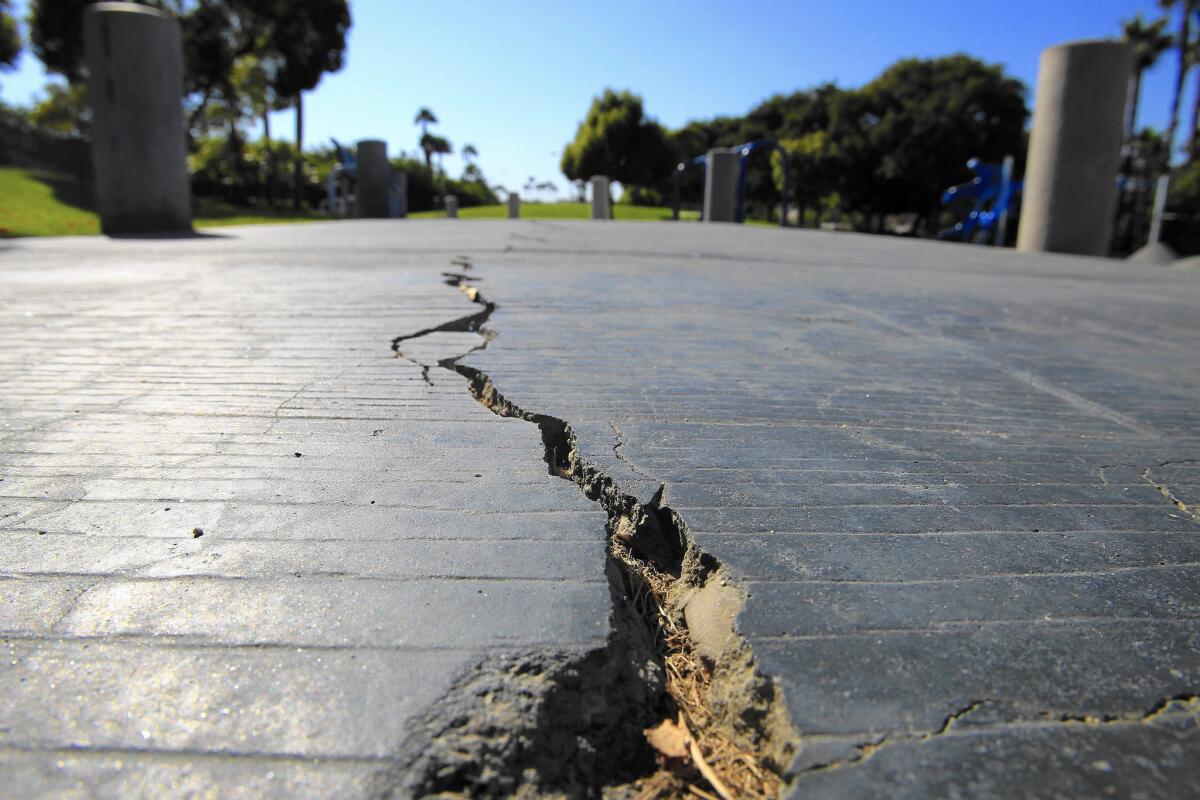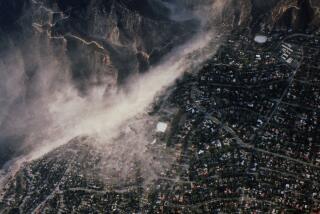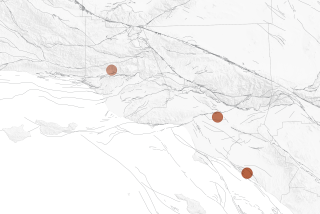Helium finding adds new wrinkle to Newport-Inglewood fault

A long crack splits the sidewalk at Discovery Well Park in Huntington Beach, which is located on top of the Newport-Inglewood fault.
When Jim Boles went to the Santa Fe Springs oil field three years ago to study helium samples, he wasn’t thinking about earthquakes. As a researcher in petroleum geology and geochemistry, Boles was studying why the temperatures were so hot underground.
Just to be thorough, he took a few other samples from nearby areas.
What he found was surprising. And his research is now sparking a new round of debate on the formations of the Newport-Inglewood fault, which was responsible for one of the most destructive earthquakes in Southern California history.
Boles didn’t realize it at the time, but some of his gas samples followed the path of the fault, which runs from Orange County to the Westside of Los Angeles. His research showed that helium was leaking deep underground through the fault.
Boles said this suggests the Newport-Inglewood fault is much deeper than what previous studies showed, connecting somehow all way to the Earth’s mantle.
“A lot of science is done by accident, but what you have to do is recognize, ‘Hey, there’s something important here that’s come out of this,’ ” said Boles, professor emeritus at UC Santa Barbara and lead author of a new study published in June. “And it has nothing to do with the original intent.”
Seismic experts said the helium doesn’t necessarily mean there is a greater quake risk on the Newport-Inglewood fault. Rather, it highlights just how much is still unknown about the deepest sections of the fault.
“This is one step closer to refining our understanding of the deep structure” of the fault, said the U.S. Geological Survey’s Ken Hudnut, who was not involved with the study. “We all live here, in Los Angeles County, right on top of a whole bunch of active faults, and we’re still stuck with inferring what the deep structure is. We don’t have clear images.”
The fault is about 46 miles long and is considered particularly hazardous because it runs through heavily populated areas, from Culver City through Baldwin Hills, Long Beach and Huntington Beach before it heads offshore.
The fault unleashed the 1933 Long Beach earthquake, which killed 120 people and prompted some of the state’s first seismic building regulations.
It’s unclear how often large quakes rupture on the fault. In just the last few months, the Newport-Inglewood fault produced several small quakes that rattled parts of the region.
The new findings do not change the way scientists forecast quakes along the fault, Hudnut said. Experts said they have long been uncertain about the depth of the Newport-Inglewood fault, so current earthquake models and calculations already factor in the possibility of a deeper fault.
Boles’ study analyzed 24 gas samples taken from oil wells along the fault. Unlike hot spots such as Yellowstone, where there is seeping magma that allows helium to escape to the Earth’s surface, helium leakage is unusual for a feature like the Newport-Inglewood fault. Here, the fault is squeezing sections of the Earth’s upper crust together, which should be limiting the passage of gas from deep beneath the ground, Boles said.
Helium, or more accurately the isotope helium-3, is a vestige of the big bang and comes from the Earth’s mantle, the layer beneath the lower crust, he said. In order for helium to be escaping from the Newport-Inglewood fault, the fissure must go deep enough through the lower crust and connect somehow to the mantle, said Boles, whose study was published in the journal Geochemistry, Geophysics, Geosystems (G-Cubed).
The Earth’s crust is at least 30 kilometers deep, Boles said. Clear images of the Newport-Inglewood fault currently go down only as far as 10 or 15 kilometers.
Also interesting, Boles said, is that he didn’t find just one helium “anomaly” along the fault. His team identified notable amounts of helium in areas from Beverly Hills to Orange County.
Helium-3 is different than the type used to blow up balloons. Although the amounts found were significant for scientists, they would probably go undetected by anyone passing by.
Scientists initially thought the Newport-Inglewood fault was similar to sections of the San Andreas fault — a so-called strike-slip fault that cuts through the Earth’s crust in a relatively vertical way.
Starting in the 1980s, however, new studies, more oil-well data and better imaging techniques prompted some scientists to reconsider what the deepest parts of the Newport-Inglewood fault might look like. New theories pointed to the possibility that a flatter, slanted fault cuts off the main sections of the Newport-Inglewood fault — which indicates that the fault might be more shallow and less vertical than initially believed.
Studying the specific angles of the fault at such depths is not easy, said Hudnut of the USGS. The helium findings suggest that seismologists might want to take another look at the original, more vertical strike-slip model of the fault.
“It’s like a pingpong volley between scientific ideas about the deep structure of the Newport-Inglewood fault,” Hudnut said. “This is the normal progression of science, right? You have one paper, and then another paper, and then another paper. And through time, the hope is that you’re getting closer to the right answer.”
Hudnut said there were several elements of the study that intrigued him. It found that the amount of helium leaking from the Newport-Inglewood fault was greater than what was found in previous helium studies of the San Andreas fault. The San Andreas fault is slipping apart roughly 10 times faster than the Newport-Inglewood one, so it would make more sense if there were more mantle-derived helium coming out of the San Andreas, Hudnut said.
Boles’ study was co-authored by a team from Tufts University, Occidental Oil & Gas Corp. and NOAA’s Pacific Marine Environmental Laboratory. The research was supported by NOAA and the U.S. Department of Energy’s Office of Basic Energy Sciences.
Boles, who said he’s no quake expert, said he hopes his team’s research leads to more studies of the fault.
“It’s like throwing a grenade into the room,” he said, recalling a colleague’s reaction to his study.
As for the original Santa Fe Springs sample that prompted his research in the first place? Boles found nothing unusual.
More to Read
Sign up for Essential California
The most important California stories and recommendations in your inbox every morning.
You may occasionally receive promotional content from the Los Angeles Times.











